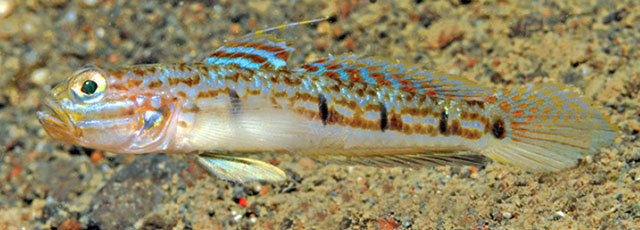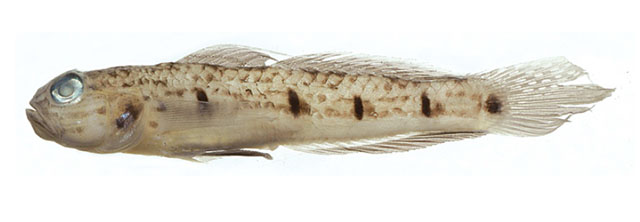Acentrogobius violarisi Allen, 2015
Description
Dorsal spines (total): 7; Dorsal soft rays (total): 11; Anal spines: 1; Anal soft rays: 11. This species is distinguished by the following characters: D VI + I,11, the dorsal spines are thin and flexible, first longest with filamentous tip, 3.2 in SL, reaching to base of about fourth or fifth soft ray of second dorsal fin when laid back; A I,11; pectoral-fin rays 16-18; lanceolate caudal fin, longer than head length; 28-29 scales in longitudinal series; 8 transverse scales; 12-13 predorsal-scales; ctenoid scales cover the body, becoming cycloid on the breast, pectoral-fin base, and nape; cheek and opercle naked; when alive colour pale grey with brown scribbling on the back, with mid-lateral row of 4 short narrow black bars and spot (at caudal-fin base) positioned between pair of brown stripes extending from pectoral fin to caudal-fin base, pair of neon blue stripes across cheek, alternating blue and brown bands on dorsal fins, and orange spots on upper half of caudal fin (Ref. 100513).
Taxonomic Hierarchy
Kingdom: Animalia
Phylum: Chordata
Class: Teleostei
Order: Gobiiformes
Family: Gobiidae
Genus: Acentrogobius
Species: Acentrogobius violarisi Allen, 2015
Climate Zone
Location
Biology
The collection area consists of moderately sloped (about 20 degrees) mud substratum (the slope begins in approximately 1.5 m depth and flattens out at about 18 m). The featureless bottom has numerous burrows occupied by a variety of fishes and invertebrates, including this new species. Fewer than ten individuals were observed on the lower section of the slope (15-18 m ) and only widely scattered, solitary individuals were seen, each of which was invariably associated with a muddy burrow (Ref. 100513).
Habitat
demersal
Conservation Status
Not Evaluated
Threat to Humans
Harmless

